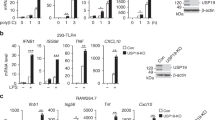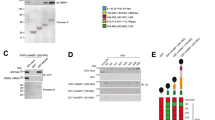Abstract
Toll-like receptor 4 (TLR4) is a key pattern recognition receptor that can be activated by bacterial lipopolysaccharide to elicit inflammatory response. Proper activation of TLR4 is critical for the host defense against microbial infections. Since overactivation of TLR4 causes deleterious effects and inflammatory diseases, its activation needs to be tightly controlled by negative regulatory mechanisms, among which the most pivotal could be deubiquitination of key signaling molecules mediated by deubiquitinating enzymes (DUBs). CYLD is a member of the USP family of DUBs that acts as a critical negative regulator of TLR4-depedent inflammatory responses by deconjugating polyubiquitin chains from signaling molecules, such as TRAF6 and TAK1. Dysregulation of CYLD is implicated in inflammatory diseases. However, how the function of CYLD is regulated during inflammatory response remains largely unclear. Recently, we and other authors have shown that Spata2 functions as an important CYLD partner to regulate enzymatic activity of CYLD and substrate binding by this protein. Here, we show that a Spata2-like protein, Spata2L, can also form a complex with CYLD to inhibit the TLR4-dependent inflammatory response. We found that Spata2L constitutively interacts with CYLD and that the deficiency of Spata2L enhances the LPS-induced NF-κB activation and proinflammatory cytokine gene expression. Mechanistically, Spata2L potentiated CYLD-mediated deubiquitination of TRAF6 and TAK1 likely by promoting CYLD enzymatic activity. These findings identify Spata2L as a novel CYLD regulator, provide new insights into regulatory mechanisms underlying CYLD role in TLR4 signaling, and suggest potential targets for modulating TLR4-induced inflammation.




Similar content being viewed by others
References
Hennessy, E. J., Parker, A. E., and O’Neill, L. A. (2010) Targeting Toll-like receptors: emerging therapeutics, Nat. Rev. Drug Discov., 9, 293-307, https://doi.org/10.1038/nrd3203.
Netea, M. G., Wijmenga, C., and O’Neill, L. A. (2012) Genetic variation in Toll-like receptors and disease susceptibility, Nat. Immunol., 13, 535-542, https://doi.org/10.1038/ni.2284.
Murray, P. J., and Smale, S. T. (2012) Restraint of inflammatory signaling by interdependent strata of negative regulatory pathways, Nat. Immunol., 13, 916-924, https://doi.org/10.1038/ni.2391.
Caballero, S., and Pamer, E. G. (2015) Microbiota-mediated inflammation and antimicrobial defense in the intestine, Annu. Rev. Immunol., 33, 227-256, https://doi.org/10.1146/annurev-immunol-032713-120238.
Fitzgerald, K. A., and Kagan, J. C. (2020) Toll-like receptors and the control of immunity, Cell, 180, 1044-1066, https://doi.org/10.1016/j.cell.2020.02.041.
Chen, Z. J. (2012) Ubiquitination in signaling to and activation of IKK, Immunol. Rev., 246, 95-106, https://doi.org/10.1111/j.1600-065X.2012.01108.x.
Adhikari, A., Xu, M., and Chen, Z. J. (2007) Ubiquitin-mediated activation of TAK1 and IKK, Oncogene, 26, 3214-3226, https://doi.org/10.1038/sj.onc.1210413.
Carpenter, S., and O’Neill, L. A. (2009) Recent insights into the structure of Toll-like receptors and post-translational modifications of their associated signalling proteins, Biochem. J., 422, 1-10, https://doi.org/10.1042/bj20090616.
Xia, Z. P., Sun, L., Chen, X., Pineda, G., Jiang, X., et al. (2009) Direct activation of protein kinases by unanchored polyubiquitin chains, Nature, 461, 114-119, https://doi.org/10.1038/nature08247.
Reiley, W. W., Jin, W., Lee, A. J., Wright, A., Wu, X., et al. (2007) Deubiquitinating enzyme CYLD negatively regulates the ubiquitin-dependent kinase Tak1 and prevents abnormal T cell responses, J. Exp. Med., 204, 1475-1485, https://doi.org/10.1084/jem.20062694.
Thiefes, A., Wolf, A., Doerrie, A., Grassl, G. A., Matsumoto, K., et al. (2006) The Yersinia enterocolitica effector YopP inhibits host cell signalling by inactivating the protein kinase TAK1 in the IL-1 signalling pathway, EMBO Rep., 7, 838-844, https://doi.org/10.1038/sj.embor.7400754.
Lamb, A., Yang, X. D., Tsang, Y. H., Li, J. D., Higashi, H., et al. (2009) Helicobacter pylori CagA activates NF-kappaB by targeting TAK1 for TRAF6-mediated Lys 63 ubiquitination, EMBO Rep., 10, 1242-1249, https://doi.org/10.1038/embor.2009.210.
Fan, Y., Yu, Y., Shi, Y., Sun, W., Xie, M., et al. (2010) Lysine 63-linked polyubiquitination of TAK1 at lysine 158 is required for tumor necrosis factor alpha- and interleukin-1beta-induced IKK/NF-kappaB and JNK/AP-1 activation, J. Biol. Chem., 285, 5347-5360, https://doi.org/10.1074/jbc.M109.076976.
Li, Q., Yan, J., Mao, A. P., Li, C., Ran, Y., et al. (2011) Tripartite motif 8 (TRIM8) modulates TNFα- and IL-1β-triggered NF-κB activation by targeting TAK1 for K63-linked polyubiquitination, Proc. Natl. Acad. Sci. USA, 108, 19341-19346, https://doi.org/10.1073/pnas.1110946108.
Zandi, E., Rothwarf, D. M., Delhase, M., Hayakawa, M., and Karin, M. (1997) The IkappaB kinase complex (IKK) contains two kinase subunits, IKKalpha and IKKbeta, necessary for IkappaB phosphorylation and NF-kappaB activation, Cell, 91, 243-252, https://doi.org/10.1016/s0092-8674(00)80406-7.
Wang, C., Deng, L., Hong, M., Akkaraju, G. R., Inoue, J., et al. (2001) TAK1 is a ubiquitin-dependent kinase of MKK and IKK, Nature, 412, 346-351, https://doi.org/10.1038/35085597.
Israël, A. (2010) The IKK complex, a central regulator of NF-kappaB activation, Cold Spring Harb Perspect. Biol., 2, a000158, https://doi.org/10.1101/cshperspect.a000158.
Silverman, N., and Maniatis, T. (2001) NF-kappaB signaling pathways in mammalian and insect innate immunity, Genes Dev., 15, 2321-2342, https://doi.org/10.1101/gad.909001.
Kawai, T., and Akira, S. (2007) Signaling to NF-kappaB by Toll-like receptors, Trends Mol. Med., 13, 460-469, https://doi.org/10.1016/j.molmed.2007.09.002.
Yu, Y., Ge, N., Xie, M., Sun, W., Burlingame, S., et al. (2008) Phosphorylation of Thr-178 and Thr-184 in the TAK1 T-loop is required for interleukin (IL)-1-mediated optimal NFkappaB and AP-1 activation as well as IL-6 gene expression, J. Biol. Chem., 283, 24497-24505, https://doi.org/10.1074/jbc.M802825200.
Mao, R., Fan, Y., Mou, Y., Zhang, H., Fu, S., et al. (2011) TAK1 lysine 158 is required for TGF-β-induced TRAF6-mediated Smad-independent IKK/NF-κB and JNK/AP-1 activation, Cell. Signal., 23, 222-227, https://doi.org/10.1016/j.cellsig.2010.09.006.
Sun, S. C. (2010) CYLD: a tumor suppressor deubiquitinase regulating NF-kappaB activation and diverse biological processes, Cell Death Differ., 17, 25-34, https://doi.org/10.1038/cdd.2009.43.
Rothschild, D. E., McDaniel, D. K., Ringel-Scaia, V. M., and Allen, I. C. (2018) Modulating inflammation through the negative regulation of NF-κB signaling, J. Leukoc. Biol., 103, 1131-1150, https://doi.org/10.1002/jlb.3mir0817-346rrr.
Lork, M., Verhelst, K., and Beyaert, R. (2017) CYLD, A20 and OTULIN deubiquitinases in NF-κB signaling and cell death: so similar, yet so different, Cell Death Differ., 24, 1172-1183, https://doi.org/10.1038/cdd.2017.46.
Mathis, B. J., Lai, Y., Qu, C., Janicki, J. S., and Cui, T. (2015) CYLD-mediated signaling and diseases, Curr. Drug Target, 16, 284-294, https://doi.org/10.2174/1389450115666141024152421.
Yang, X. D., Li, W., Zhang, S., Wu, D., Jiang, X., et al. (2020) PLK4 deubiquitination by Spata2-CYLD suppresses NEK7-mediated NLRP3 inflammasome activation at the centrosome, EMBO J., 39, e102201, https://doi.org/10.15252/embj.2019102201.
Kupka, S., De Miguel, D., Draber, P., Martino, L., Surinova, S., et al. (2016) SPATA2-mediated binding of CYLD to HOIP enables CYLD recruitment to signaling complexes, Cell Rep., 16, 2271-2280, https://doi.org/10.1016/j.celrep.
Wagner, S. A., Satpathy, S., Beli, P., and Choudhary, C. (2016) SPATA2 links CYLD to the TNF-α receptor signaling complex and modulates the receptor signaling outcomes, EMBO J, 35, 1868-1884, https://doi.org/10.15252/embj.201694300.
Elliott, P. R., Leske, D., Hrdinka, M., Bagola, K., Fiil, B. K., et al. (2016) SPATA2 links CYLD to LUBAC, activates CYLD, and controls LUBAC signaling, Mol. Cell, 63, 990-1005, https://doi.org/10.1016/j.molcel.2016.08.001.
Schlicher, L., Wissler, M., Preiss, F., Brauns-Schubert, P., Jakob, C., et al. (2016) SPATA2 promotes CYLD activity and regulates TNF-induced NF-κB signaling and cell death, EMBO Rep., 17, 1485-1497, https://doi.org/10.15252/embr.201642592.
Wei, R., Xu, L. W., Liu, J., Li, Y., Zhang, P., et al. (2017) SPATA2 regulates the activation of RIPK1 by modulating linear ubiquitination, Genes Dev., 31, 1162-1176, https://doi.org/10.1101/gad.299776.117.
Tokunaga, F., Sakata, S., Saeki, Y., Satomi, Y., Kirisako, T., et al. (2009) Involvement of linear polyubiquitylation of NEMO in NF-kappaB activation, Nat. Cell Biol., 11, 123-132, https://doi.org/10.1038/ncb1821.
Tokunaga, F., Nakagawa, T., Nakahara, M., Saeki, Y., Taniguchi, M., et al. (2011) SHARPIN is a component of the NF-κB-activating linear ubiquitin chain assembly complex, Nature, 471, 633-636, https://doi.org/10.1038/nature09815.
Emmerich, C. H., Schmukle, A. C., and Walczak, H. (2011) The emerging role of linear ubiquitination in cell signaling, Sci. Signal., 4, re5, https://doi.org/10.1126/scisignal.2002187.
Qian, W., Li, Q., Wu, X., Li, W., Li, Q., et al. (2020) Deubiquitinase USP29 promotes gastric cancer cell migration by cooperating with phosphatase SCP1 to stabilize Snail protein, Oncogene, 39, 6802-6815, https://doi.org/10.1038/s41388-020-01471-0.
Lopez-Castejon, G., and Edelmann, M. J. (2016) Deubiquitinases: novel therapeutic targets in immune surveillance, Mediators Inflamm., 2016, 3481371, https://doi.org/10.1155/2016/3481371.
Harrigan, J. A., Jacq, X., Martin, N. M., and Jackson, S. P. (2018) Deubiquitylating enzymes and drug discovery: emerging opportunities, Nat. Rev. Drug Discov., 17, 57-78, https://doi.org/10.1038/nrd.2017.152.
Sowa, M. E., Bennett, E. J., Gygi, S. P., and Harper, J. W. (2009) Defining the human deubiquitinating enzyme interaction landscape, Cell, 138, 389-403, https://doi.org/10.1016/j.cell.2009.04.042.
Funding
This work was supported by grants from the National Key R&D Program of China (2021YFA1301400), Shanghai Municipal Science and Technology Major Project (ZD2021CY001), National Natural Science Foundation of China (31770818) and Shanghai Science and Technology Commission (21ZR1456300).
Author information
Authors and Affiliations
Contributions
X.D.Y. conceived the project; Z.Z. and S.Z. performed the experiments; X.J., D.W., and Y.D. contributed to the performance of the experiments; Z.Z, X.J., and X.D.Y. analyzed data and wrote the manuscript; X.D.Y. supervised the project.
Corresponding author
Ethics declarations
The authors declare no conflicts of interests in financial or any other sphere. All applicable international, national, and institutional guidelines for the care and use of animals were followed.
Electronic supplementary material
Rights and permissions
About this article
Cite this article
Zhang, Z., Zhang, S., Jiang, X. et al. Spata2L Suppresses TLR4 Signaling by Promoting CYLD-Mediated Deubiquitination of TRAF6 and TAK1. Biochemistry Moscow 87, 957–964 (2022). https://doi.org/10.1134/S0006297922090085
Received:
Revised:
Accepted:
Published:
Issue Date:
DOI: https://doi.org/10.1134/S0006297922090085




